#3d Machine Vision industry
Explore tagged Tumblr posts
Text
3d Machine Vision Market - Forecast(2024 - 2030)
3D Machine Vision System Market Overview
3D Machine Vision System Market Size is forecast to reach $5.9 billion by 2027, at a CAGR of 11.9% during forecast period 2022-2027. The need for inspection of flaws and controlling a specific task of industrial operations is motivating the utilization of 3D Machine Vision Systems in process control and quality control applications. Additionally, the growing penetration of automation and robotics across various industries and rapid advancements in industrial technologies along with the need for higher productivity are boosting the deployment of 3D Machine Vision Systems. These systems encounter wide range of applications in various industry verticals including oil& gas, aerospace, transportation, automotive among others and are able to serve their inspection needs with the available types such as PC-based and smart camera based 3D Machine Vision Systems. 3D Machine vision systems have been utilized for a number of growing applications including object recognition, automatic inspection, Optical sorting as a real time information for robot controllers. This will drive the market significantly.
Report Coverage
The report: “3D Machine Vision System Market Report– Forecast (2022-2027)”, by IndustryARC covers an in-depth analysis of the following segments of the Brushless DC Motor market
By Product Type: PC Based, Smart Camera Based By Component: Hardware (Camera, Frame Grabber, Lighting, Processor, Optics), Software (Application Specific, Deep Learning) By Application: Quality Assurance and Inspection, Position Guidance, Measurement, Identification, Pattern Recognition and Others By End Users: Automotive, Electrical and Electronics, Healthcare, Consumer Electronics, Aerospace and Defense, Logistics, Security and Surveillance, Printing, ITS, Machinery, Packaging, Food and Beverage and Others By Geography: North America (U.S, Canada, Mexico), South America (Brazil, Argentina, Chile, Colombia and Others), Europe (Germany, UK, France, Italy, Spain, Russia and Others), APAC (China, Japan India, Australia and Others), and RoW (Middle East and Africa)
Request Sample
Key Takeaways
The rising need for advanced manufacturing in the U.S have increasingly demanded the use of 3D Machine Vision Systems.
The market players are majorly opting for various strategies such as product launch, partnership and agreements and collaborations to gain market traction and further penetration to explore the hidden opportunities in upcoming trends including Industry4.0
Recognizing trends and irregularities in production processes early on machine vision paves the way for realizing the smart factory of the future. Machine vision ensures safety in production process as well as quality in the end product.
3D Machine Vision System Market Segment Analysis - By Component
3D Machine Vision System and components market is led by cameras which are estimated to surpass $3.2 billion by 2027 majorly driven by the advancements in imaging technology. The 3D Machine Vision System industry is expected to grow during the forecast period due to continued evolution of CMOS image sensors, rise in demand for automation in industrial applications and increased investments in R&D of smart camera and software by key players, such as Cognex Corporation, Teledyne Technologies, Inc., Keyence Corporation, and others. The global 3D Machine Vision Systems and components market has increased due to the rapid penetration of automation across several industry verticals. Moreover, the development of advanced sensors and software algorithms capable of offering precise and microscopic inspection in high speed production lines is escalating the growth rate of the market. Machine Vision market is estimated to witness significant growth in the coming years, on account of increased adoption in various industries for automatic inspection and control of machines or processes by capturing and interpreting and analyzing an image.
Inquiry Before Buying
3D Machine Vision System Market Segment Analysis - By End Use Industry
Automotive industry is expected to witness a highest CAGR of 14.1% the forecast period, owing to increasing investments, and funds for semiconductors has been providing opportunities for adoption of automation technology which further set to drive the demand of connectors in semiconductor industry. These systems encounter wide range of applications in various industry verticals including oil& gas, aerospace, transportation, automotive among others and are able to serve their inspection needs with the available types such as PC-based and smart camera based 3D Machine Vision Systems. Investments by the U.S automakers for strengthening of the manufacturing of automobiles with increasing integration of recent robotic vision technologies in vehicles is accompanying the growth of the robotic vision market in the U.S. Industry revenue is projected to continue grow due to this development.
3D Machine Vision System Market Segment Analysis - By Geography
3D Machine Vision System market in Europe region held significant market share of 38% in 2021. The investments are rising for electric, connected and autonomous vehicles and this in turn The U.S. accounted a huge market base for Machine Vision due to the growing adoption of 3D Machine Vision System technology by vision companies continues to witness exploration for new applications in a variety of industries. which are driving the machine vision market driven by a push from companies such as Google and Verizon. The rising initiatives in Middle East and Africa for the increasing need of automation is set to propel the machine vision market. The growth of manufacturing industry in Africa and Middle East (AME) is expected to grow at a rate of 14.2% between 2021 and 2025 thereby significantly driving the market
Schedule a Call
3D Machine Vision System Market Drivers
Growing Demand for Smart Cameras
Smart cameras often support a 3D Machine Vision System by digitizing and transferring frames for computer analysis. A smart camera has a single embedded image sensor. They are usually tailored-built for specialized applications where space constraints require a compact footprint. Smart cameras are employed for a number of automated functions, whether complementing a multipart 3D Machine Vision System, or as standalone image-processing units. Smart cameras are considered to be an effective option for streamlining automation methods or integrating vision systems into manufacturing operations as they are cost-efficient and relatively easy to use. There is a huge demand for smart cameras in industrial production as manufacturers often use them for inspection and quality assurance purposes. Smart cameras are growing at a 9.7% CAGR with Machine vision being a premier use case. Thus, increasing demand for smart cameras will drive the 3D Machine Vision Systems market growth in various industrial applications.
Increasing need for quality products, high manufacturing capacity
3D Machine Vision Systems perform quality tests, guide machines, control processes, identify components, read codes and deliver valuable data for optimizing production. Modern production line are advanced and automated. Machine vision enables manufacturing companies to remain competitive and prevent an exodus of key technologies. Recognizing trends and irregularities in production processes early on machine vision paves the way for realizing the smart factory of the future. Machine vision ensures safety in production process as well as quality in the end product. As a result of this, according to an IDG survey by Insight, 96% of Companies surveyed think computer vision has the capability to boost revenue, with 97% saying this technology will save their organization time and money across the board.
3D Machine Vision System Market Challenges
Lack of awareness among users and inadequate expertise
The robotic vision technology is rapidly changing, with new technologies emerging constantly, and new tools coming to market incredibly fast to make tackling automation problems easier. In the past decade alone, the robotic vision market has seen the introduction of more advanced sensors in terms of both smaller pixels and larger sensors, software platforms that continues to be more accurate, and lighting which is growing brighter and becoming more efficient. The high cost of the research and development in robotic vision and the lack of awareness among users about the rapidly advancing robotic vision technology are key factors likely to hinder the market to an extent.
Buy Now
3D Machine Vision System Industry Outlook
Product launches, acquisitions, Partnerships and R&D activities are key strategies adopted by players in the market. 3D Machine Vision System top companies include
Cognex
Omron Corp
Sony Corp.
Panasonic Corp.
Microscan
Basler AG
Keyence Corp.
National Instruments
Sick AG
Teledyne Technologies
FLIR
Recent Developments
In July, 2021 Cognex launched its new series of vision software “VisionPro” for industrial machine vision enabling customers to combine deep learning and traditional vision tools in the same application.
In March 2021, Omron launched FH-SMD Series 3D Vision sensors for robotic arms enabling space-saving assembly, inspection, and pick & place and other applications.
#3d Machine Vision Market#3d Machine Vision Market size#3d Machine Vision industry#3d Machine Vision Market share#3d Machine Vision top 10 companies#3d Machine Vision Market report#3d Machine Vision industry outlook
0 notes
Text
#3D Machine Vision Market#3D Machine Vision Market Research#3D Machine Vision Market Industry#3D Machine Vision Market Reports#3D Machine Vision Market Trends#3D Machine Vision Market Growth
0 notes
Text
"It seems like a new Silicon Valley startup could change the face of the battery industry forever by utilizing 3D printers to print solid-state batteries.
Solid-state batteries have advantages over lithium-ion because they aren’t flammable, they’re more easily recycled, work in extreme cold, and have greater energy density.
Solid-state batteries have traditionally been difficult to machine manufacture. But by using 3D printing arrays filled with powder, Sakuu systems can make these batteries not only using 40% less material, but in almost any shape the customer might want.
An electric bike could be powered by a battery that hugs a section of the central chassis, or a smartphone’s battery could run all the way around the frame of a circuit board. These unorthodox shapes are just one of the many advantages that Sakuu believe they can offer.
“Many people have built cells in the lab, but they have not been able to scale,” Sakuu CEO and founder Robert Bagheri told Fast Company. “Our vision started with that scalability in mind.”
The array, known as a Kavian, is much smaller than the traditional, “roll to roll” battery manufacturing methods, and because the powder loaded into the 3D printers can be extremely precise, there’s a 40% reduction in materials usage—a huge cost savings over competitors.
The batteries they print can be charged to 80% in just 15 minutes.
Because they can be printed in any shape, all kinds of clever innovations are possible, in all kinds of industries from e-mobility products to wearables and small devices. The company is even working with an aviation company that wants solid-state batteries for their aircraft with holes through the middle of it to help with heat management."
-via Good News Network, 2/27/23
#battery#batteries#tech industry#electricity#recycling#3d printing#lithium ion battery#good news#hope
169 notes
·
View notes
Text
A COLD LOOK AT CANADIAN HORROR IN BRANDON CRONENBERG’S ANTIVIRAL

When Americans think of Canada, they usually think of preternaturally-polite hosers sitting in igloos, drinking Molson or Labatt beer, watching hockey on the CBC as they dunk their Tim Hortons doughnuts in maple syrup, all the while dreaming of clubbing seals (much to Morrissey’s dismay). I don’t think Americans give much thought to Canada at all, and that’s okay. We’re not a threat to national security (despite our nationwide legalization of cannabis), we supply you with a steady stream of actors and comedians, and we’re your #1 economic trading partner, so what’s to worry about? Except that Canada concocts your nightmares, dear friends, and the irony is simply delicious: who would expect a bland nation-state of moose-loving people to be sinister sadists? It’s particularly omnipresent when watching Canadian horror films. Our film industry is, well, a speck of dust compared to the mighty Hollywood machine, but, occasionally, our celluloid chillers travel south of the 49thparallel and feast on your delicate minds. Since 1961’s The Mask (in 3D!), Canada has impacted the horror genre with its domestic terror: Black Christmas, My Bloody Valentine, Prom Night, The Changeling, Curtains, Blood and Donuts, Cube, Ginger Snaps, and more recent fare like American Mary, Pyewacket, and the Wolf Cop films. Who else would make a movie about an insane killer with a pickax terrorizing Moosehead-swilling Nova Scotia miners? Only in Canada, eh? This collection of Canadian horror helped inspire a new generation of talent to make big impressions with small budgets with such films as Beyond the Black Rainbow and Antiviral, the latter a film so American in its examination of celebrity worship, but at heart very Canadian, with a distinct connection to its filmic past.
In order to examine Antiviral, one cannot ignore the influence of Canada’s greatest and best-known filmmaker, David Cronenberg. With his over-sized glasses and gangly appearance, Cronenberg looks like an English major who shuns sunlight in order to read Angela Carter stories in a library basement, but his dark creativity has no equal. If the term body horror applied to any one filmmaker, it’s Cronenberg. With his full-length debut, Shivers (made with Canadian government money—”screw you, taxpayer”, as the Kids in the Hall used to say), Cronenberg created a nightmare vision of an isolated luxury Montréal apartment tower gone awry; not unlike J. G. Ballard’s novel, High-Rise, but with a parasitic-organism twist. Despite its low-budget exploitation origins, Shivers was more than just schlocky fun—it heralded the arrival of a unique cinematic voice in a national film industry known more for documentaries than narrative cinema. With each film, Cronenberg expanded his obsession with the human body and technology, culminating with Videodrome (1983) and The Fly (1986), arguably his two most acclaimed films. Cronenberg’s breakthrough in the USA helped fellow Canadian filmmakers like Atom Egoyan, Patricia Rozema, Bruce MacDonald, Guy Maddin, Lynne Stopkewich, and a handful of others impress the American independent film community; Canadian film budgets were on par with the likes of Jim Jarmusch and Hal Hartley. By the ’90s, Cronenberg moved away from horror, but horror never truly left him: from adaptations of two of his literary heroes, William S. Burroughs’ Naked Lunch (1993) and J. G. Ballard’s Crash (1996), to eXistenZ (1999), Spider (2002), A History of Violence (2005), and his last (and possibly final) film, Map to the Stars (2014). Outside of The Fly, his films have never electrified the box office, but they have always been profitable worldwide, allowing him to remain in Toronto with his loyal film crew; a rarity in an industry that often forces Canadian creatives to flee to Hollywood for exposure and employment. Cronenberg has been an influence on aspiring Canadian filmmakers and his influence on contemporary Canadian cinema, including Antiviral, is evident.
Antiviral is the product of artist/filmmaker Brandon Cronenberg, son of David, so it’s no coincidence that the film draws influences from Cronenberg Senior’s work. I’m reminded of a quote from Superman, “The son becomes the father, and the father…the son.” I don’t seek to diminish Brandon’s work in Antiviral by referencing his famous father, but rather acknowledge a debut so accomplished, even as raw as it is, that it can be attributed partly to the influence of his father’s work. And make no mistake, there are elements in Antiviral that wouldn’t seem out of place in Papa David’s work. The film played at Cannes and TIFF in 2012, received mostly good reviews, and then disappeared, which is a shame, as it’s a rewarding low-budget film that will connect with film aficionados who like their cinema on the cold and satirical side.
In an unnamed Canadian metropolis, Syd March (Caleb Landry Jones), an employee of Lucas Clinic, aids people in becoming closer to their favorite celebrities by injecting them willingly with various viruses collected from the rich and famous. Lucas Clinic’s number one celebrity, Hannah Geist (Sarah Gadon) is nearly too popular to keep all their clients happy. Syd steals viruses to sell on the black market by injecting himself surreptitiously, transferring them into the Ready-Face console, a revolutionary machine that identifies the “face of the virus” for copyright protection from competitors, removing it from the incubator—Syd—and preventing the virus from spreading to another host. When a fellow Lucas Clinic salesman is arrested for viral theft, Caleb is instructed to obtain a strange new virus Geist has contracted in China that is sure to be highly profitable. Syd wrecks his machine trying to transfer the new virus and the media has reported that Geist has died. Realizing that he’s dying from the same disease, Syd tangles with corporate competitors and black marketeers in the hope of finding a cure.
Brandon Cronenberg doesn’t make it easy for the casual filmgoer to enjoy Antiviral: it is, by intention, a cold film—we’re talking Kubrickian cold—so it’s not one to pop into the Blu-ray player on a sleepy weeknight. The film’s characters and setting don’t provide humanity or warmth and it’s highly apparent in the desaturation of color: the Lucas Clinic (likely named in honor of George Lucas and his first film, THX 1138, a fellow dystopian film drained of color and humanity) is a sterile monochromatic shrine to all things white. Syd’s apartment is also white and spartan, save for the Ready-Face console hidden away in his closet. Lucas employees, mostly men (save for a woman who’s in charge of the clinic’s pathogen storage), all wear dark suits and white shirts uniformly—there are no pops of color, stylish glasses, or fun pocket squares. Even Lucas Clinic’s competitor, Vole and Tessier, is no less drab, its corridors equally lifeless and industrial. Everyone looks pale, particularly Syd, even before he injects himself with viruses; people everywhere appear ghoulish because they’re not living, they’re merely existing, consuming nothing but celebrity news (and maybe a side of celebrity brisket). Most shots feel like fluorescence was used for lighting and it aids in the ghoul factor, if not making for a beautiful image. Antiviral’s exterior shots of Toronto and nearby Hamilton (often—and unfairly—ridiculed by Torontonians as being the “Pittsburgh of Canada”) indicate a cold, drab, overcast sky over a city without beauty—nothing but an industrial wasteland (sorry again, Hamilton).
The film borrows from several famous dystopian sources, but it’s Aldous Huxley’s Brave New World that Antiviral shares the strongest connection (not to disrespect George Orwell’s 1984, which I think is a fine dystopian novel, great for teachable moments in school, kids, but I’ve always felt Huxley’s novel is far more subtle and insidious of a society that lacks genuine human interaction and emotion, courtesy of soma and feelies). In Antiviral, there is no connection between people—everyone stares transfixed at TV screens that display endless celebrity gossip. Drugs don’t appear to be a distraction—it’s the allure of feeling connected to a celebrity that’s as powerful as any drug. Everyone is subdued, and there is little in the way of emoting unless it’s reacting to a celebrity’s death or accident. Before he can transfer his purloined pathogens to the Ready-Face console, Syd’s landlady observes that he looks like he’s becoming ill (something his co-workers state repeatedly), but not out of care or concern; his well being is an obstacle to her perpetual gossip consumption. Outside of minutiae, the only thing discussed between the two is Hannah Geist. His co-workers discuss with him the types of maladies suffered by celebrities, but nobody asks personal questions. They stand in line to pick up the latest disease (Aria Noble, another deified celebrity, has a flu virus labeled S-915) to pass along to their customers; no small-talk about weekends spent or marital problems, just work work work. Syd speaks softly to his clients, inspiring them with the chance to be close to their favorite celebrity via a unique disease, but it’s just a polished sales pitch. Black marketeers assault Syd in order to steal a virus (oh and a sample of that rash) in casual fashion because humans are a commodity, thanks to the rich and famous who sell their illnesses to greedy corporations. Humanity is not a never-ending series of adventures, it’s a means to one end: feeling like being in a celebrity’s skin.
Antiviral also shares a connection to Philip K. Dick with the Ready-Face machine, something the infamously-paranoid author could have easily conjured in one of his many fever dreams. Like much of Dick’s classic science fiction novels, the Ready-Face is a remarkable piece of technology and innovation, but its collection of gears and clunky parts suggest otherwise. The idea that a private corporation has developed a technology to identify person’s unique disease and prevent its “unlawful” duplication is also something akin to Dick’s world of tape-spewing simulacrums used for corporate profit. Lucas Clinic’s founder, Dorian Lucas (Nicholas Campbell), repeatedly spouts bland corporate platitudes about serving the public’s celebrity worship and “propriety rights” of pathogens, selling his thinly-veiled dream of avarice to his employees in a staff gathering. The Ready-Face technology is incredible, but nothing else in the world seems as it should—some people think the film is set in the near future, but if so, it’s one in which smartphones and other personal devices don’t exist. I like to think of Antiviral as existing in a parallel reality, one in which HD TVs exist, but everything is analogous to analog technology—Syd uses a flip alarm clock radio (ask your parents, kids!). Perhaps budgetary limitations are at work, but I think it’s fitting: in a world where there is only celebrity obsession, how could innovation exist beyond the desire to exploit a profitable opportunity? Syd’s world is akin to the Earth as depicted in Dick’s Do Androids Dream of Electric Sheep? (the inspiration for Blade Runner), in which all the ambitious, innovative humans have left their home world for dazzling colonies in the solar system; the people who remain on Earth are the disenfranchised, the unambitious, the sick and elderly, and the criminal dregs of society. In the world of Antiviral, there is no societal progression, only stasis, as people are content only to be close to their beloved celebrity.
As a piece of satire, Antiviral is truly horrific—people paying great sums of money, willing to endure painful maladies to feel close to a famous person is completely absurd, especially in 2012, when the film was released, but even seven years later, the volume of media focused on celebrity has grown exponentially. Many of us watch TMZ daily for celebrity news (or to be “culturally aware”, as Lynne, a dear former co-worker described it). We use smartphones and apps to track the movements of celebrities; traditional advertising using celebrity spokespeople isn’t just found on TV and magazines (while they exist), but in social media apps. People on Instagram are often called “influencers” (which truly makes my blood run cold), desperate to attract more followers by pitching companies’ wares for free swag or remuneration. The Kardashians, a cabal—sorry, a family–of craven, profit-hungry individuals who are not famous as the result of any creative endeavor, but because they’re simply wealthy (their dad knew OJ!) are the antecedent to Antiviral’s Hannah Geist. As a celebrity, she is nearly god-like: her image is everywhere and worshipped, but she’s unobtainable unless one experiences one of her diseases. Even her personal doctor, Dr. Abendroth (a wonderfully subdued Malcolm McDowell), a man of science, is not immune to her power as a goddess. He confesses to Syd that Hannah isn’t just a patient to him, and the viewer suspects he has genuine personal feelings for her, but, alas, he too is under her spell, as he proffers an arm that features several skin grafts of Hannah and others (Papa Cronenberg would be proud). Society continues to distract itself by “living” vicariously through a chosen few, stagnating at the expense of that devotion. All the positive attributes of humanity are missing: no pursuit of knowledge, no ambition to improve oneself, no progression of any kind. There is only corporate greed exploiting an inert society and the black marketeers want a piece of that action: “I don’t even think ‘dignity’ is still a valid currency,” remarks one unsavory marketeer, confirming how devolved humanity has become.
I would be remiss if I didn’t mention the butcher shop, Astral Bodies Meat Market. Oh, it’s a window into a different time, when a customer could go walk in, the jingle of the door bells alerting smiling butchers, and calmly pick up a couple of pork chops and a side of bacon. In Antiviral, ye olde butcher shop has transformed into something hilarious and yet terrifying: it sells celebrity meat (Soylent Green indeed)! During my initial viewing, I thought the butcher shop nicknamed cuts of meat with celebrity names, but no, it is literal human muscle tissue, grown from cells sold to them by said celebrities. The butcher, Arvid (a calmly creepy Joe Pingue), who moonlights as a pathogen black marketeer, slices celebrity skin nonchalantly, offering a sample to Syd, free of charge (it’s even wrapped in craft paper and butcher’s twine). When Hannah dies from her mysterious illness, the demand for her “meat” increases, creating a lineup outside of Astral Bodies, customers impatient to buy what few cuts remain (don’t worry—Arvid is harvesting those cells for a future limited-time-only sale). One could argue that Astral Bodies is a bit of heavy-handedness, but I think it’s demonstrative of the celebrity communion theme in Antiviral; it’s funny and creepy at the same time, but it’s a satirical note in the unhealthy devotion to unattainable people.
What’s also very telling is that at no point does the viewer learn what specifically has catapulted Hannah into stardom. I thought she was a famous actor, but multiple viewings confirm her enigmatic celebrity. Sarah Gadon appears angelic (Brandon having borrowed from his father’s repertory company), but she doesn’t appear very much in the film; her character, however is always present in some form, always discussed, and the impetus for corporate espionage. The only flourishes of color involve Hannah, whether by flowers surrounding her bed as she recuperates from an illness in China (but not too sick to sell it to Lucas Clinic) and a video recreation of her (the film’s analog “virtual reality”) surrounded by red velvet curtains. Even Syd feels the pull of her power–in one pivotal scene there is a Christ-like communion involving Hannah’s blood that he performs in her honor. Color is only worthy of a god—Hannah’s worshippers can must remain in a monochromatic existence. Her mother, Dev (Sheila McCarthy), and Dr. Abendroth are concerned about her health as she succumbs to the disease, but it’s not so much for her well being as it is for her value as a commodity and status as a god. Dev Geist is a stand-in for Kris Jenner, she of the nauseating sobriquet “momager”, a woman with a vested interest in her daughter in order to acquire additional wealth and power. Dev and the doctor concoct a bit of subterfuge by faking Hannah’s death, as it’s revealed that Vole and Tesser are behind Hannah’s unknown illness, compliments of corporate sabotage. Syd is the key to finding an antidote, so he has value, but not as a person, but as another means to an end; altruism is very dead in Antiviral. The faked death has unintended, but profitable consequences for some: Syd, slowly deteriorating from Hannah’s disease, is kidnapped by one black marketeer in order to film his descent into death: “Since her tragic passing, many of Hannah’s admirers have experienced what could be described as an uncomfortable narrative gap between her life and funeral.” Syd is to be a living-yet-dying testament to Hannah for all to see: he’s placed in a sterile white room containing only a cot and Hannah’s visage adorned to each wall. It’s all part of an elaborate corporate scheme of legal loopholes and immorality that is depressing and inhuman as one can imagine. Everyone is a commodity, voluntarily or not.
Brandon Cronenberg’s Antiviral is a clever piece of satire, able to tell its story on a modest budget and it succeeds. Syd is not a likeable character by design; he’s a vessel, literally and figuratively, to narrate an unnerving tale of a society that has ignored its own needs for the sake of worshipping others. The film is unrelentingly bleak, much like David Cronenberg’s best films, and there is no happy ending—it exists as a Swiftian warning to the viewer: wake the hell up! Focus on your own life, don’t be a sycophant or a disciple who shrivels away in distraction. Beware of the false idols, lest ye sacrifice thine own humanity (does that sound Biblical enough?). Antiviral is an impressive introduction to Brandon Cronenberg and I’m giddy with anticipation for his second film, the upcoming Possessor (with Jennifer Jason Leigh!). Getting a film financed isn’t easy, particularly in Canada (I imagine a grant submission to Telefilm Canada is a nightmare in its own right), so Brandon Cronenberg’s Antiviral is an artistic accomplishment, itself an inspiration for the next wave of Canadian filmmakers, but one that wears the father’s influence proudly and reverently.
2 notes
·
View notes
Text
Honey, It's the Twenties! Part 5 December 31, 2023

The home stretch, it gets kinda heavy before the slow quiet comedown. Happy New Years Eve afternoon!
listen on Mixcloud
Cel Ray - Clorox Wipes
DJ speaks over Fugazi - Turkish Disco
Warm Exit - Ultra Violence Litige - Casual Tonight Bloodstains - Anti-Social Fairytale - Brick Flowers Chain Whip - Class Decay Exploatör - Uttråkad
Nervous Triggers - Radiation Suit Rat Cage - Emotional Blackmail GLAAS - Haymarket Riot Waltz Disintegration - Hit the Face Clock Of Time - Swallow the Feed
RIBBON STAGE - Her Clock Tower Enemic Interior - Les Vies Skill Issue - Soot Pigeon - Bad Visions Fake Fruit - Yolk PhysiQue - Moreover Heavy Mother - Psychic Attitude Sanctus Iuda - Nowy Różaniec
KNOWSO - Do the Work Rotten Mind - Unflavored Psico Galera - Prima Del Giudizio En Attendant Ana - Anita Golpe - Teoria in Pratica Destruct - Throughout the War People's Temple - No Way Out
Taxi Girls - Sunshine Catalogue - Houseplant Cutters - Twister SIAL - Tali Collate - Medicine Irreal - Odie Als Veins Double Job - Decouverte
Water Machine - Blisters Industry - Totalitarian Domination Ratos do Beco - Solidão Brandy - Text Home The Stools - Evangelista Yellowcake - Indiscriminate Shelling
Class - Grid Stress Futura - ¿Sera El? UNIDAD IDEOLÓGICA - Inhabilitado Para Reaccionar SULUS - Ürün Kün Dummy - Daffodils Arrest - Mentirán Slant - Modern Addictions 3D and the holograms - C4 Spirito Di Lupo - S.D.L.
Young Marble Giants - Final Day CDG - Living between The Barbed Wires - Last Resort Beef - Backlash Peace Talks - Vanity Enzyme - Masquerade Qlowski - Larry's Hair Everywhere
AutopsiA - Quiero Tenerte para Aplastarte Nightfeeder - Species on the Brink Subdued - The Joke
Damu The Fudgemunk - Four Better or Worse, Pt. 4
#radio#community radio#punk#music#playlist#post punk#wprb#new wave#hardcore punk#garage rock#egg punk#crust#dbeat#indie rock#indie#power pop
2 notes
·
View notes
Text

The Future of Artificial Intelligence in Graphic Design: Where Creativity Meets Technology
Artificial Intelligence (AI) has been making waves across various industries, and the field of graphic design is no exception. With advancements in machine learning and computer vision, AI is revolutionizing the way designers create, optimize, and enhance visual content. In this blog post, we will explore the exciting future of AI in graphic design and how it is reshaping the industry.
AI-powered tools are streamlining design processes, allowing graphic designers to work more efficiently. Automated design platforms can generate layouts, compositions, and even entire designs based on given input, saving designers time and effort. Machine learning algorithms can also analyze vast amounts of data, including user preferences and market trends, to generate personalized design recommendations. This integration of AI into the design workflow enables designers to focus more on the creative aspects, while repetitive and time-consuming tasks are handled by intelligent algorithms.
Artificial intelligence is enabling designers to create visually stunning content with greater precision and sophistication. AI algorithms can analyze images, recognize patterns, and generate realistic visual effects, such as realistic 3D rendering and lifelike animations. Additionally, AI-powered image editing tools can automatically enhance and retouch images, adjusting colors, removing imperfections, and optimizing compositions. These advancements empower designers to push the boundaries of creativity, producing captivating visual content that captures attention and engages audiences on a deeper level.
The future of AI in graphic design lies in its ability to deliver personalized user experiences. By leveraging machine learning, designers can create dynamic and adaptive interfaces that cater to individual user preferences. AI algorithms can analyze user behavior, demographics, and preferences to tailor visual elements, layouts, and content in real-time. This level of personalization enhances user engagement, satisfaction, and ultimately, the effectiveness of design. As AI continues to evolve, we can expect increasingly sophisticated and intuitive design systems that seamlessly adapt to the unique needs and preferences of each user.
The future of AI in graphic design is a promising one, where technology and creativity converge to unlock new possibilities. From streamlining design processes and enhancing visual content to delivering personalized user experiences, AI is reshaping the industry in profound ways. By embracing AI as a powerful ally, designers can unlock their creative potential and take design to new heights.
To see samples of print design visit: https://www.g3creative.co.uk/print-design-glasgow
3 notes
·
View notes
Text
Okay so this is gonna be a big rant. I didn't check my sources, I'm going to say things that are wrong. You're going to have to live with it.
Around the time of windows 8 Microsoft tried to reinvent itself. It was tired of being the stuffy, skeuomorphic machine you were assigned at work. They wanted to be cool. Part of this vision was a complete redesign of the interface

And I don't know, call me crazy, I think this visual design fucks. I mean look at this. It's simplistic but gorgeous. The rest of the industry was running away from skeuomorphism towards simplicity via rounded bulbous corners. This was distinct, it was colorful, it had contrast, it was sharp. It literally looked like a bunch of windows in a pane.
At the time, Microsoft was also launching a windows phone (much to late to make a difference. They missed the boat but they didn't know it yet) and were designing a new Xbox that would have architecture near identical to that of a PC. The idea was that they were expanding beyond just stuffy PCs, there were a lot of new product categories and they wanted a universal version of windows that could handle all of them. You could build a "Universal Windows Platform" app that would run on any version of windows on any device. This was achieved using the C# virtual machine that us CS people tentatively affectionately call "Microsoft Java".
The future that Microsoft envisioned would be that there would be a new walled garden of software that you would run on all your pretty new windows devices. They would all share and sync and be perfect and pretty, and the same app on your phone could be played on your xbox, pc, and holy shit AR GOGGLES?
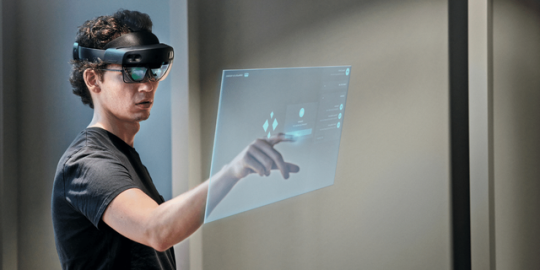
Yeah these fucking things. Microsoft bet big on the idea we'd like to start doing shit with holograms. They made this cool-ass device that used projectors to shine shit into your eye so you could see holograms and poke them and move them about. These were Windows devices that ran actual full-on windows, but that meant that Windows' identity had to grow to accommodate them. All the UIs had to work in a world where you'd see them on a touch screen OR as a hologram. All of the first party software had to have that in mind.
MS paint? Nah that shit's ancient. We got PAINT 3D and it's the most dogshit thing you've ever used
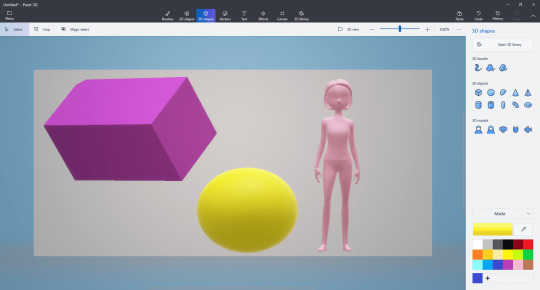
All the sloppy jank of MS paint but now you can put horrible fucking 3d models in it. I'm holding back my full Paint 3d thoughts for a later post that's still being worked on in the drafts, but here's a sneak preview.
Paint 3d allows you to dip into a catalogue of 3d models and plop them into your regular MS paint canvas. There's still no layers, no vector support, but hey at least you can add transparent backgrounds. Paint 3d let you export your horrible janky creations both as a regular png/jpg but also as a 3d model.
that's your short answer. They added that 3d models folder because of paint 3d. If you want to leave now you can... but this post keeps going as you can see.
The idea would be that as more of our tech moved to AR and VR you would be acquiring 3d models at a similar rate that you do other file times, so it made sense to have a built in folder. Maybe you work at one of those offices in an microsoft ad where I guess people just email each other .fbx flower pots for some fucking reason? Maybe you're downloading them from the metaverse (we weren't calling it that back then).
Your friend using a hololense would make a 3d model and then send it to you, you'd add some shit to it in paint 3d using its kafkaesque interface, then send it back. Wow. The future is so much fun.

You could even stick your 3d models in your very own VR start menu. Yeah. To go along with the AR goggles they released some dogshit (well they were good for the time and also cheap compared to the competition) VR goggles. These things ran on the SAME uwp platform as everything else, so theoretically I could make some abomination in paint 3d and then send it to my dad who works at the flower pot factory or some shit and he could put it on his virtual desk in his virtual cliff house start menu where he would virtually alt tab between a hovering window of Microsoft word and some freaky VR porn that his boss couldn't catch him watching because it was all in the headset.
That didn't fucking happen. We don't do that. And it's not just because it was a terrible idea but also because Microsoft wasn't committed to the bit.
See this house of cards came crashing down for a lot of reasons. The first one being that it wasn't backwards compatible. This cool 3d virtual, cross-device future wasn't with the win32 api, but the new UWP api. Devs had to remake their software in a less performant programming language and format just so it would run on all windows devices... but windows for PC still ran the win32 style apps that already worked. So you were expecting devs to port their windows app to... to windows... so it could run on windows... even though it was already running on windows. Oh yeah, let's just rewrite our whole accounting software stack so that bill can use it on his windows phone because phones are definitely for doing accounting and not playing fucking candy crush.
xkcd 927
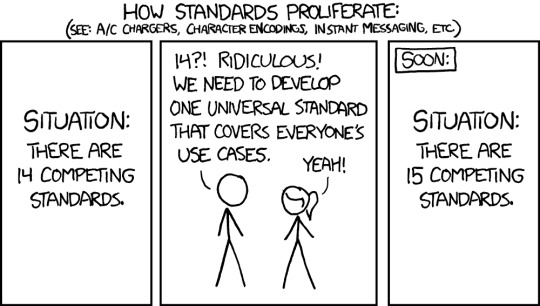
UWP added the functionality of "It works on xboxes, vr googles, windows phones, AND computers but just a little bit worse than the other ones and you have to remake it from scratch". It was just one more competing standard, and the use case of cross platform didn't really help that much.
The windows phone died out early on because it was too late and it couldn't cross the app gap (even though it's UI totally fucked and you play a halo twin stick shooter on it). The hololense died because it cost them ONE THOUSAND dollars just to build the screen assembly for one eye, you needed two of those + an onboard computer to run AR + a fuckload of cameras + proffit. No one was ever going to spend that kinda of cash just so they could pinch and zoom semi transparent holograms in a tiny 40 degree feild of vision in for two and a half hours because yeah the battery life was shit too. Developers never made software for it because there would never be any install base because something that superfluous can't ever be that expensive while we're all getting poorer.
Now, the VR headsets on the other hand, they kinda sucked... but they were cheap and they were competent. With a bit of elbow grease you could make them be just as good as the pretty boys, and they were the first to market with inside out tracking which was legitimately freeing back in 2018. Microsoft could have integrated it with the Xbox to compete with PSV but they just didn't for no fucking reason even though they both ran UWP apps and were on the same appstore and used all the same ports and the Xbox was just about powerful enough to play some games in VR. Yeah they just didn't commit to the bit and abandoned their VR headset line because it didn't instantly become a monopoly despite them putting very little effort into it.
So windows phone died, windows VR died, hololense died, and now regular windows 10 is full of the corpses of this cross platform vision. We have the 3d objects folder even though nothing really uses it anymore. Windows 10 never fully upgraded to the metro theme. It's like... half metro but some settings require you go to the old XP control panel. Some windows are in metro style but then when you right click on them there's just a standard win32 dialogue box that's ugly and white. It's been that way since 2015 and rather than finishing windows 10 and making it pretty they stuffed it full of bullshit and ads and then said "FUCK IT, WINDOWS 11"

And windows 11's whole thing is being ugly and simplistic and rounded corners and wasted space and designed for a touch screen because even though the windows phone died at least the 2 in one windows tablet market was doing okay.
Windows is a collection of good ideas, followed by a bag fumble, followed by an admission of defeat and a retreat to the familiar.
And somewhere along the way we got a new folder for 3d objects, and if you really want you can use paint 3d to make this shit I guess:
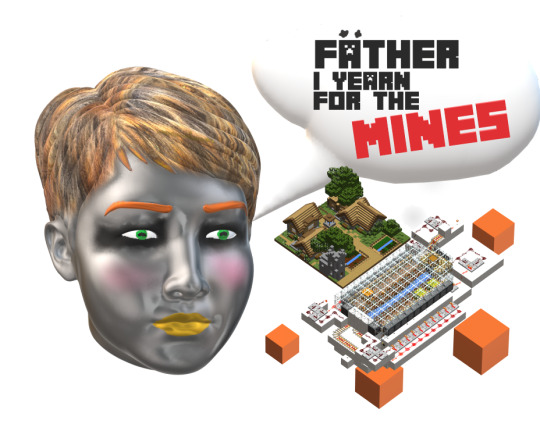


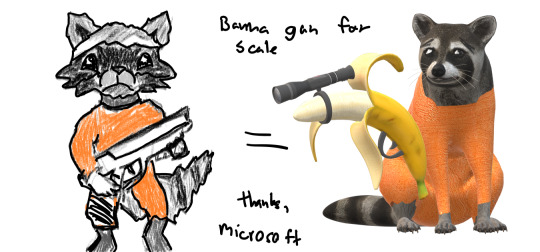
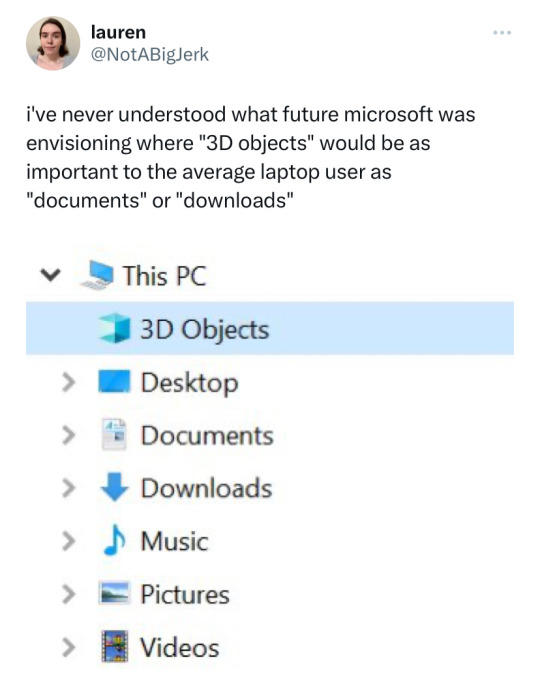
#Quohotos' unhinged rants that no one asked for#Microsoft#Windows#paint3d#paint 3d#rant#UX design#UX#interface design#graphic design
106K notes
·
View notes
Text
Exploring the Future of Technology: Lidar Vision, Robots, and Road Profiling
The technological landscape is rapidly evolving, and some of the most exciting innovations are rooted in advanced sensing technologies. Among these, Lidar vision, a laser-based system, is revolutionizing various industries, from robotics to road profiling. At the forefront of this change are companies like Red Sensors, offering innovative solutions to meet the growing demand for precision, accuracy, and efficiency. This blog delves into the key concepts of Lidar vision, its application in robots, its role in laser systems, and how it's transforming road profiling.
What is Lidar Vision?
Lidar, which stands for Light Detection and Ranging, is a cutting-edge technology that uses laser light to measure distances. Lidar vision refers to the integration of this technology with advanced imaging systems. By emitting laser pulses and analyzing the reflected light, Lidar creates highly accurate 3D maps of its surroundings. This allows it to detect obstacles, measure distances, and build detailed visualizations of objects in the environment.
Unlike traditional imaging technologies like cameras, Lidar can provide accurate depth perception even in low-light or challenging weather conditions. This makes it an essential tool in numerous applications, particularly in robotics and autonomous vehicles.
Lidar Vision for Robots
The integration of Lidar vision in robots has unlocked new frontiers for automation. Robots equipped with Lidar sensors can "see" their environment in three dimensions, enabling them to navigate complex spaces with precision. Whether it's an industrial robot on a factory floor or a robot designed to deliver packages, Lidar vision allows these machines to avoid obstacles, map their surroundings, and even collaborate with humans safely.
The Lidar vision for robots is particularly valuable in applications requiring autonomy and real-time decision-making. These robots can adjust their movements based on the continuous stream of data from Lidar sensors, adapting to dynamic environments without human intervention. This results in more efficient, effective, and safer robotic systems.
The Role of Laser Systems
At the heart of Lidar vision is the laser system, which plays a pivotal role in the emission and reception of laser light. Laser systems are designed to emit high-powered, precise laser beams that travel to objects in the environment and return as reflected light. The system measures the time it takes for the light to return, allowing it to calculate the distance to the object.
Laser systems are central to many technologies, from surveying to environmental monitoring. In the context of Lidar vision, these systems ensure that the data gathered is both accurate and reliable, contributing to the overall effectiveness of the technology in a variety of applications.
Road Profiling with Lidar
One of the most impactful uses of Lidar is in road profiling, a process that involves creating detailed maps of road surfaces for various purposes, including infrastructure maintenance and planning. Traditional road profiling methods are often time-consuming and prone to errors. With Lidar, road profiling becomes more efficient, with the ability to generate highly accurate 3D maps of roads and highways.
Lidar-based road profiling can detect minute imperfections in road surfaces, such as cracks or potholes, and provide valuable data for maintaining infrastructure. This technology is transforming how municipalities and companies approach road maintenance, reducing costs, improving safety, and extending the lifespan of roads.
The Impact of Lidar Technology
Lidar technology is not just a game-changer for robotics and road profiling; it also has applications in a wide range of industries. From autonomous vehicles to environmental monitoring, Lidar offers unprecedented accuracy in mapping and data collection. Its ability to operate in diverse conditions, such as night, fog, and rain, makes it a versatile tool for the future.
For companies like Red Sensors, the integration of Lidar technology into their product offerings ensures they stay ahead of the curve. With their advanced laser systems and Lidar solutions, they empower industries to harness the full potential of this groundbreaking technology.
Why Choose Red Sensors?
At Red Sensors, they understand the transformative power of Lidar vision and laser systems. Their commitment to providing high-quality solutions has made them a trusted partner for industries seeking to leverage advanced technology. Whether you're looking for Lidar solutions for robotics, road profiling, or other applications, Red Sensors offers the expertise and cutting-edge products you need to succeed.
For more information on Lidar systems and how they can benefit your business, visit Red Sensors today. They are at the forefront of Lidar technology, helping industries around the world navigate the future with precision and accuracy.
Conclusion
The future of technology is undeniably shaped by advancements in Lidar vision, robotics, and laser systems. From enhancing the capabilities of robots to revolutionizing road profiling, Lidar is paving the way for a smarter, more efficient world. Companies like Red Sensors are leading the charge, providing innovative solutions that make these technologies accessible and impactful across various industries.
0 notes
Text
Building Dynamic and Interactive 3D Game Environments

Introduction
The gaming industry has experienced a massive transformation over the years, with advancements in 3D modeling games, real-time rendering, and interactive environments pushing the boundaries of realism and engagement. Creating 3D game environments requires a combination of artistic vision, technical skills, and cutting-edge tools to deliver immersive experiences. From open-world landscapes to detailed indoor spaces, every element contributes to a title's overall feel and gameplay. In this blog, we explore the key aspects of building dynamic 3D game assets and how they enhance interactivity in modern gaming.
The Role of 3D Modeling in Game Environments
1. Creating Realistic Assets
3D modeling games rely on high-quality assets to create believable environments. Artists use software like Blender, Maya, and 3ds Max to craft detailed 3D game assets such as buildings, terrain, and props. The accuracy of these assets significantly impacts the visual appeal and realism of the game world.
2. Optimizing for Performance
While high-detail assets are crucial, optimizing them for performance is equally important. Developers use techniques like level of detail (LOD), texture baking, and polygon reduction to ensure that 3D game environments run smoothly on various hardware configurations without compromising visual fidelity.
3. Procedural Generation for Large Worlds
Many modern games utilize procedural generation techniques to create expansive 3D game environments. This approach helps in generating unique landscapes, reducing manual work, and maintaining variety in open-world games. Tools like Houdini and Unreal Engine’s procedural mesh tools allow developers to create dynamic terrains efficiently.
Designing Interactive 3D Game Environments
1. Physics-Based Interactions
Interactivity is crucial for enhancing player immersion. Implementing physics-based mechanics, such as destructible objects, ragdoll effects, and real-time simulations, makes 3D game environments feel more alive. Popular physics engines like NVIDIA PhysX and Havok enable realistic interactions within a game world.
2. AI-Driven Environmental Elements
Game environments can be made more dynamic with AI-driven elements, such as NPC behaviors, weather changes, and adaptive lighting. These elements create a living world that reacts to player actions, making the experience more engaging and unpredictable.
3. Sound and Visual Effects Integration
Ambiance and sound design play a significant role in making 3D game assets feel immersive. Elements such as dynamic lighting, environmental audio cues, and particle effects enhance realism and draw players deeper into the experience.
Best Tools for Building 3D Game Environments
1. Unreal Engine 5
Unreal Engine 5 provides high-end tools like Nanite and Lumen, allowing developers to create highly detailed 3D game environments with real-time lighting and performance optimization.
2. Unity
Unity is a versatile game engine that supports interactive 3D modeling games, making it a great choice for indie and large-scale projects alike. Its asset store provides thousands of ready-to-use 3D game assets to speed up development.
3. Blender and Maya
Both Blender and Autodesk Maya are industry-standard tools for creating detailed 3D game assets. They offer advanced modeling, texturing, and animation capabilities to bring game worlds to life.
The Future of 3D Game Environments
As gaming technology evolves, 3D game environments are becoming more sophisticated. With advancements in ray tracing, machine learning, and virtual reality, the next generation of 3D modeling games will be more immersive than ever. The integration of AI-driven world-building and procedural content generation will further revolutionize game development, allowing for dynamic and interactive experiences beyond what we can imagine today.
Conclusion
Building engaging 3D game environments requires a blend of artistic creativity and technical expertise. From crafting realistic 3D game assets to designing interactive worlds, every aspect contributes to the overall gaming experience. As technology continues to evolve, game developers will have even more tools to create breathtaking, immersive worlds that captivate players. Whether you're a game designer, artist, or enthusiast, understanding the process behind these environments is key to appreciating the artistry behind modern gaming.
0 notes
Text
Price: [price_with_discount] (as of [price_update_date] - Details) [ad_1] From the brand PremiumFitness Equipment Brand Our vision is to promote fitness awareness worldwide and ensure accessibility to fitness equipment in every corner of the planet. PowerMax is a leading name in the fitness equipment industry, dedicated to helping individuals lead healthier lives. with a commitment to excellence, we have been serving fitness enthusiasts for over two decades. Our extensive range of high-quality fitness equipment, including treadmills, exercise bikes, elliptical trainers, and strength machines are designed to cater to the diverse needs of our customers. Best Home Use Treadmills Best Home Use Exercise Bikes Best Home Use Ellipticals 【Feature & Display】12 pre-set athelete workout programs for you to set variable exercise mode for Weight Loss Training, Strenght Traning, Endurance Training,3 target based modes. 3D Smart Touch display,Hearth Rate Sensor,Time,Speed, Distance,Calories,Safety Key. 【Treadmill Motor】2 Hp Powerfull Dc Motor, Shockproof Design , Noice less, Queiest exercise machine for home, Delivers Speed upto 1 - 14 Kilometer per hour to achive your fitness goal.This Makes It best Treadmill For Home Use 【Running Machine Belt】Scientific Soft 6 Layer Running Belt, High Density,Skid proof and rebound resilience function. Large Belt Track 1260mm*420mm, Walk,Jog,Sprint,Run. World Class Exercise Equipment For Home 【Incline 】3 Level Manual Incline Treadmill helps to burn calories at remarkable faster pace, This features helps For Cardiovascular,Muscle Traning,Body Toning,Keep Your Self In shape 【WARRANTY】-Life time Frame warranty on trade mill , 3 year motor warranty and 1 year warranty on parts against manufacturing defects.It is suggested to use a 1000 VA stabilizer. In-Box Contents: 1 treadmill, toolkit, user manual and warranty card. 【Personalized User Weight Capacity】A choice aligned with you. With a maximum user weight capacity of 115kg,PowerMax Treadmill accommodates various users. For enhanced longevity and performance, Powermax recommends factoring in an additional 25KG buffer for running.
Consider your weight as a reference point for selecting the treadmill's capacity. For example, if your weight is 75 kg or less, a 100 kg max capacity treadmill is suitable [ad_2]
0 notes
Text
Machine Vision Market: Innovations in 3D Vision & Imaging Technology - UnivDatos
According to a new report by Univdatos Market Insights, the Machine Vision Market is expected to reach around USD 25.64 billion in 2032 by growing at a CAGR of 8.8%. Machine vision can be defined as the technology and systems employed in imaging-based automatic inspection and analysis in use such as quality assurance, inspection, and process control. It enables an object to analyze and perform actions concomitant to vision as compared to human vision though a lot less accurate and slower. Machine vision systems can be as simple as having a camera, a lens, and light to process a particular image and have an interface by which information can be transferred. These systems may be comprised of a mere barcode reader or may cover fully automatic systems that help a robot on the factory floor, or a machine detect extremely small flaws in almost real-time high-speed production.
Request To Download Sample of This Strategic Report - https://univdatos.com/get-a-free-sample-form-php/?product_id=65983&utm_source=LinkSJ&utm_medium=Snehal&utm_campaign=Snehal&utm_id=snehal
Global Demand for Machine Vision
1. Industrial Automation:
One of the many factors for the increased demand for machine vision is the encouragement of automation in manufacturing. Automated systems have made it easier for factories since they check the quality of what they produce thus avoiding more mistakes. Automation is not only time saving but also reduces the involvement of humans which not only saves money but also helps to avoid accidents in dangerous areas.
2. Technological Advancements:
Current advancements in machine learning and AI plus the use of deep learning are making these machine vision systems more effective and flexible. With an enhancement of the resolution of the camera, the processing software, and the computing capacity, machine vision can be implemented in more difficult and complex scenarios like in the diagnosis of diseases, or self-driving cars.
3. Global Expansion of Automotive and Electronics Sectors:
This has been a result of the growth of the automotive and electronics industries, especially in Asia-Pacific where demand for machine vision has been realized. Since manufacturers in these sectors demand accuracy and quality assurance in production, machine vision is an indispensable tool in the production of components including semiconductors, circuit boards, and vehicle parts.
Applications of Machine Vision
1. Manufacturing and Quality Control
In manufacturing, the most applied field of machine vision is used in quality assurance and for inspection. Automated visual inspection is useful in identifying defects, imperfections, or variations in shape, size, or colour that might have occurred during production hence making sure that the consumer is not sold substandard products. Some areas that are hard for a human being to see, points like surface cracks, wrong joining or lack of parts, are matters of detail that machine vision systems can easily detect. These types of systems facilitate increased speed of production, and accuracy of processing in addition to reducing errors arising out of manual operations.
2. Automotive Industry
The main use of machine vision in automotive manufacturing is the use of the vision system in assembly line processes and operations as well as the development of self-driving cars. Automated vision systems make it possible to achieve a high degree of accuracy in the placement of parts and in applications like welding, painting, and assembling components by robots which is otherwise a complex task.
3. Healthcare and Medical Diagnostics
In healthcare, there is greater usage of machine vision systems in imaging techniques such as X-ray, MRI, and CT scans to improve doctors’ diagnosis of diseases. In laboratories, machine vision is used in activities such as the analysis of blood samples, counting cells, and identifying peculiarities in medical images. Consequently, Machine vision technology is predicted to have a higher importance in the identification of early diseases and the use of customized medicine in the future.
4. Retail and Logistics
Machine vision is also being applied in retail and logistics industries as it comes in the use of barcode scanning, grouping of products, and stock management. Machine vision that is used in Amazon Go stores helps identify purchased items and record the checkout process without scanning those products with handheld scanners. In warehouses, machine vision systems are used in such operations as picking and packing where robots take charge thus minimizing human contact.
Recent Developments/Awareness Programs: - Several key players and governments are rapidly adopting strategic alliances, such as partnerships, or awareness programs: -
• December 2022 - German innovator in lighting technology SAC Sirius Advanced Cybernetics GmbH ("SAC") has been acquired by Cognex. The acquisition broadens Cognex's reach into sectors like automotive and consumer electronics that produce products quickly and with little tolerance for failures that endanger safety.
• September 2022 - To support the NVIDIA Jetson OrinTM Nano system-on-modules (SOMs), which have raised the bar for entry-level edge Artificial Intelligence (AI) and robotics, Basler introduced add-on camera kits with 5 and 13 MP.
• September 2022 - The 2-megapixel Optimom from Teledyne e2v is a collection of turnkey optical modules that can be "instantly" integrated into embedded-vision systems. It has a compact board, an FPC connector that is widely used in industry, an integrated low-noise global shutter image sensor from Teledyne e2v, and supplemental lenses.
• August 2021- The innovative "VT-S10 Series" PCB inspection system has been released by OMRON Corporation. With the help of this system, high-precision inspection of electronic substrates is automated without the need for specialized knowledge.
Ask for Report Customization - https://univdatos.com/get-a-free-sample-form-php/?product_id=65983&utm_source=LinkSJ&utm_medium=Snehal&utm_campaign=Snehal&utm_id=snehal
Conclusion:
The global machine vision market is expected a lot of growth soon because of technological development, automation, AI, and the coming up of Industry 4.0. Due to its versatility in manufacturing, automotive, health care, and electronic industries, machine vision has become an essential tool for improving quality, productivity, and safety. In the future, increasing technological improvement of vision systems will allow for higher and more diverse performance benefits in areas such as upcoming self-driving cars and individualized medicine. The future of the machine vision market can be described as promising with huge potential for further development of new and unique solutions. According to the UnivDatos Market Insights analysis, the rise in industrial robots and their applications in inspection, quality control, and guidance is a major driver of the market. Furthermore, smart factories and Industry 4.0 initiatives promote machine vision integration for process optimization. The market was valued at USD 12.2 billion in 2023, growing at a CAGR of 8.8% during the forecast period from 2024 - 2032.
0 notes
Text
The Future of Autonomous Vehicle Datasets with GTS.AI
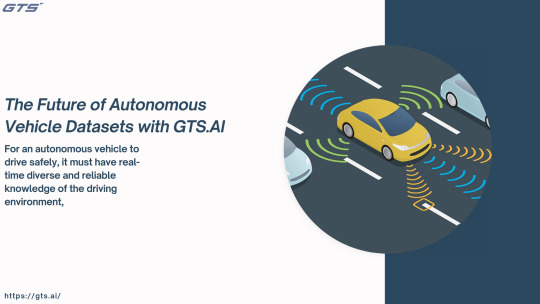
The autonomous vehicle Dataset represents a commendable step in the advancement of transportation technology, ensuring safety, efficiency, and ease of use. The high-quality datasets at the heart of these self-driving systems are crucial. These datasets are essential in training and refining the machine learning models necessary for autonomous vehicles to navigate complex locations.
Generating and Providing the Datasets for Autonomous Driving
For an autonomous vehicle to drive safely, it must have real-time diverse and reliable knowledge of the driving environment, make sound decisions, and perform movements accordingly. This process is known as the perception-decision-action cycle, which threatens data. Good datasets become the basis of information that different types of machine learning algorithms use to recognize objects, estimate motions, and plan trajectories.
Some datasets are complex, comprising:
Visual Data: Images and videos collected by cameras mounted on the vehicle to form a visual map of the environment.
LiDAR Data: Light Detection and Ranging data primarily representing 3D point clouds through which the vehicle calculates distances and recognizes obstacles. Radar Data: Used to determine the velocity and position of objects, ideal in adverse weather conditions. GPS and IMU Data: These provide detailed information on the position and movement of the vehicle.
In order for AV systems to process, the diverse data sets should be properly synchronized and labeled. Annotations could include labeling objects (pedestrians and traffic signs), segmenting drivable surfaces, or marking lane boundaries.
The Fourfold Challenges of Collecting Quality Datasets
Collecting and curating datasets for autonomous cars entails several challenges.
Diversity of Scenarios: AVs must be outfitted to deal with a wide variety of traffic conditions, ranging from various weather conditions, lighting changes, and various traffic situations. Such variability can only be accomplished through thorough data collection efforts. Volume of Data: The amount of data that is gathered by sensors is tremendous. Thus, the sheer volume of data makes it imperative to store, manage, and process the data effectively. Annotation Complexity: This is laborious; only through an arduous process of painstaking checking will a dataset provide reliable training data for machine-learning models. Privacy Concerns: The collection of data in public spaces raises some pressing privacy concerns, which needs to be dealt with by mechanisms that ensure the anonymization of sensitive information.
GTS.ai: Pioneering High-Quality Data Collection
To overcome these challenges, an expert with extensive experience in data collection and annotation must be called. Globose Technology Solutions, or GTS.ai, stands at the forefront of this domain by offering high-caliber data collection services that emphasize the human touch. With over 25 years of this practice under the belt, GTS.ai specializes in the delivery of highly customized datasets for machine learning applications.
GTS.ai's Services
Collection of Image and Video Data-Creation of specialized datasets, including traffic videos and urban scenes, that train perception systems in AVs. Annotation Services-The application of various annotation techniques to ensure image and video identification and thus improve the accuracy of the generated data by machine learning models. Collection of Speech and Text Data - Collection and annotation of audio and text data supporting natural language processing applications regarding the automotive industry.
Using the expertise of GTS.ai, organizations will now source datasets that are sound and carefully tailored to meet the different needs posed by autonomous driving systems.
Case Study: Case Study in Autonomous Vehicle Driving Dataset
The first case study showcasing GTS.ai capacities is about KITTI Vision Benchmark Suite, an already well-known dataset in the AV research community. The particular collection is rich in terms of high-resolution pictures and 3D cloud points from various driving scenarios for worth resources in AV training or evaluation.
gts.ai
GTS.ai founded this dataset and labeled it so that it can suit the rigors of machine learning applications in autonomous vehicles. This particular activity emphasizes the purpose of GTS.ai in good quality data solutions to help improve the AV technology.
A Look at Future Autonomous Vehicle Datasets
With both autonomous driving technology and the dataset being worked on and improved, the pressure for more sophisticated and broad-ranging datasets is only going to grow. Future datasets must cover a wider variety of situations, including infrequent and edge cases, to allow the AVs to successfully handle situations that may occur in the real world. Combine that with the rise of approaches for fusing simulation data with real-world data. Simulated data would therefore afford additional scenarios that remain hard to achieve or dangerous to collect in real life.
In this dynamic landscape, companies like GTS.ai play a crucial role. With their expertise in the collection and annotation of this data, AV developers get the data rich in quality that drives evolution and makes sure safe and reliable autonomous vehicles are on our roads. In closing, the journey to fully autonomous vehicles is data-driven. Solid datasets lay the foundations for AV systems themselves to perceive, decide, and act within complicated environments. With organizations such as GTS.ai making a concerted effort, that future is looking increasingly intelligent and autonomous.
0 notes
Text
Automotive 3D Printing Market To Witness the Highest Growth Globally in Coming Years

The report begins with an overview of the Automotive 3D Printing Market 2025 Size and presents throughout its development. It provides a comprehensive analysis of all regional and key player segments providing closer insights into current market conditions and future market opportunities, along with drivers, trend segments, consumer behavior, price factors, and market performance and estimates. Forecast market information, SWOT analysis, Automotive 3D Printing Market scenario, and feasibility study are the important aspects analyzed in this report.
The Automotive 3D Printing Market is experiencing robust growth driven by the expanding globally. The Automotive 3D Printing Market is poised for substantial growth as manufacturers across various industries embrace automation to enhance productivity, quality, and agility in their production processes. Automotive 3D Printing Market leverage robotics, machine vision, and advanced control technologies to streamline assembly tasks, reduce labor costs, and minimize errors. With increasing demand for customized products, shorter product lifecycles, and labor shortages, there is a growing need for flexible and scalable automation solutions. As technology advances and automation becomes more accessible, the adoption of automated assembly systems is expected to accelerate, driving market growth and innovation in manufacturing. Automotive 3D Printing Market Size, Share & Industry Analysis, By Technology Type (Electronic Beam Melting (EBM), Selective Laser Sintering (SLS), Digital Light Processing (DLP), Fused Disposition Modelling (FDP)), By Material Type (Ceramic, Metal, Polymer), By Application Type (Production, Innovation and R&D, Prototyping) and Regional Forecast 2021-2028
Get Sample PDF Report: https://www.fortunebusinessinsights.com/enquiry/request-sample-pdf/103613
Key Strategies
Key strategies in the Automotive 3D Printing Market revolve around optimizing production efficiency, quality, and flexibility. Integration of advanced robotics and machine vision technologies streamlines assembly processes, reducing cycle times and error rates. Customization options cater to diverse product requirements and manufacturing environments, ensuring solution scalability and adaptability. Collaboration with industry partners and automation experts fosters innovation and addresses evolving customer needs and market trends. Moreover, investment in employee training and skill development facilitates seamless integration and operation of Automotive 3D Printing Market. By prioritizing these strategies, manufacturers can enhance competitiveness, accelerate time-to-market, and drive sustainable growth in the Automotive 3D Printing Market.
Major Automotive 3D Printing Market Manufacturers covered in the market report include:
The major companies in the global 3D printing market include 3D Systems Corporation, Stratasys Ltd., Arcam AB, EnvisionTEC, Ponoko Limited, The ExOne Company, Autodesk Inc., Hoganas AB, Optomec, Inc., Voxeljet AG among others.
Globally, the rise in urbanization, high standard of living, and increased demand of customers are leading to an increase in the automotive industry. Furthermore, the adoption of advanced technology, less time required to manufacture intricate designs, low cost of raw materials, innovation in printing methods an also investment of government to develop new technology is driving the growth of the market. However, the lack of skilled laborers and high printing costs may hamper the growth of the market.
Trends Analysis
The Automotive 3D Printing Market is experiencing rapid expansion fueled by the manufacturing industry's pursuit of efficiency and productivity gains. Key trends include the adoption of collaborative robotics and advanced automation technologies to streamline assembly processes and reduce labor costs. With the rise of Industry 4.0 initiatives, manufacturers are investing in flexible and scalable Automotive 3D Printing Market capable of handling diverse product portfolios. Moreover, advancements in machine vision and AI-driven quality control are enhancing production throughput and ensuring product consistency. The emphasis on sustainability and lean manufacturing principles is driving innovation in energy-efficient and eco-friendly Automotive 3D Printing Market Solutions.
Regions Included in this Automotive 3D Printing Market Report are as follows:
North America [U.S., Canada, Mexico]
Europe [Germany, UK, France, Italy, Rest of Europe]
Asia-Pacific [China, India, Japan, South Korea, Southeast Asia, Australia, Rest of Asia Pacific]
South America [Brazil, Argentina, Rest of Latin America]
Middle East & Africa [GCC, North Africa, South Africa, Rest of the Middle East and Africa]
Significant Features that are under offering and key highlights of the reports:
- Detailed overview of the Automotive 3D Printing Market.
- Changing the Automotive 3D Printing Market dynamics of the industry.
- In-depth market segmentation by Type, Application, etc.
- Historical, current, and projected Automotive 3D Printing Market size in terms of volume and value.
- Recent industry trends and developments.
- Competitive landscape of the Automotive 3D Printing Market.
- Strategies of key players and product offerings.
- Potential and niche segments/regions exhibiting promising growth.
Frequently Asked Questions (FAQs):
► What is the current market scenario?
► What was the historical demand scenario, and forecast outlook from 2025 to 2032?
► What are the key market dynamics influencing growth in the Global Automotive 3D Printing Market?
► Who are the prominent players in the Global Automotive 3D Printing Market?
► What is the consumer perspective in the Global Automotive 3D Printing Market?
► What are the key demand-side and supply-side trends in the Global Automotive 3D Printing Market?
► What are the largest and the fastest-growing geographies?
► Which segment dominated and which segment is expected to grow fastest?
► What was the COVID-19 impact on the Global Automotive 3D Printing Market?
Table Of Contents:
1 Market Overview
1.1 Automotive 3D Printing Market Introduction
1.2 Market Analysis by Type
1.3 Market Analysis by Applications
1.4 Market Analysis by Regions
1.4.1 North America (United States, Canada and Mexico)
1.4.1.1 United States Market States and Outlook
1.4.1.2 Canada Market States and Outlook
1.4.1.3 Mexico Market States and Outlook
1.4.2 Europe (Germany, France, UK, Russia and Italy)
1.4.2.1 Germany Market States and Outlook
1.4.2.2 France Market States and Outlook
1.4.2.3 UK Market States and Outlook
1.4.2.4 Russia Market States and Outlook
1.4.2.5 Italy Market States and Outlook
1.4.3 Asia-Pacific (China, Japan, Korea, India and Southeast Asia)
1.4.3.1 China Market States and Outlook
1.4.3.2 Japan Market States and Outlook
1.4.3.3 Korea Market States and Outlook
1.4.3.4 India Market States and Outlook
1.4.3.5 Southeast Asia Market States and Outlook
1.4.4 South America, Middle East and Africa
1.4.4.1 Brazil Market States and Outlook
1.4.4.2 Egypt Market States and Outlook
1.4.4.3 Saudi Arabia Market States and Outlook
1.4.4.4 South Africa Market States and Outlook
1.5 Market Dynamics
1.5.1 Market Opportunities
1.5.2 Market Risk
1.5.3 Market Driving Force
2 Manufacturers Profiles
Continued…
About Us:
Fortune Business Insights™ delivers accurate data and innovative corporate analysis, helping organizations of all sizes make appropriate decisions. We tailor novel solutions for our clients, assisting them to address various challenges distinct to their businesses. Our aim is to empower them with holistic market intelligence, providing a granular overview of the market they are operating in.
Contact Us:
Fortune Business Insights™ Pvt. Ltd.
US:+18339092966
UK: +448085020280
APAC: +91 744 740 1245
#Automotive 3D Printing Market#Automotive 3D Printing Market Share#Automotive 3D Printing Market Size#Automotive 3D Printing Market Trends#Automotive 3D Printing Market Growth#Automotive 3D Printing Market Insights#Automotive 3D Printing Tech
0 notes
Text
https://orbit3d.ae
Architectural Scale Model Makers in Dubai, UAE
Dubai is a city of architectural wonders, where breathtaking skyscrapers, luxurious villas, and futuristic developments define the skyline. Behind these grand structures lies a crucial element in the architectural design process—scale models. These miniature replicas bring architectural concepts to life, allowing architects, real estate developers, and investors to visualize projects before construction begins.
Among the top architectural scale model makers in Dubai, Orbit3D stands out for its precision, innovation, and expertise in delivering high-quality models. Let’s explore the world of architectural scale models, their importance, and why Orbit3D is the best choice for scale model making in Dubai.
What Are Architectural Scale Models?
Architectural scale models are miniature representations of real estate, urban planning, and infrastructure projects. They serve as detailed physical models that showcase design, structure, and layout in a tangible form. These models are essential for developers, architects, and city planners to communicate their vision effectively.
Types of Architectural Scale Models
Conceptual Models – Used in the early design stages to explore ideas and spatial relationships.
Presentation Models – High-quality models designed for client presentations, marketing, and exhibitions.
Urban Planning Models – Showcasing entire city layouts, including roads, landscapes, and buildings.
Interior Models – Focusing on detailed interiors, including furniture and room layouts.
Industrial and Engineering Models – Used for industrial plants, oil refineries, and mechanical components.
Importance of Architectural Scale Models
1. Enhanced Visualization
Scale models provide a three-dimensional perspective that blueprints and 3D renderings cannot fully convey. They help stakeholders understand spatial relationships, scale, and aesthetics before actual construction begins.
2. Better Communication
Architects and developers can use models to explain designs to clients, investors, and regulatory bodies. A physical model makes it easier to interpret complex architectural details.
3. Marketing and Sales Tool
For real estate developers, a physical model is a powerful sales tool. Potential buyers and investors can visualize the property’s appearance and layout, making it easier to generate interest and close deals.
4. Error Detection and Refinement
Scale models help identify design flaws and potential construction challenges early in the planning process, reducing costly mistakes and modifications during actual construction.
Orbit3D – Leading Architectural Scale Model Makers in Dubai
Dubai has a competitive market for architectural scale models, but Orbit3D has earned a strong reputation for its exceptional craftsmanship and technological innovation. Here’s why Orbit3D is the best choice for scale model making in Dubai.
1. Advanced 3D Printing and CNC Technology
Orbit3D uses cutting-edge 3D printing, CNC machining, and laser cutting technology to create highly detailed and precise models. These advanced techniques ensure accuracy in every aspect of the model, from the smallest details to the overall structure.
2. High-Quality Materials
Using premium materials such as Acrylic, ABS plastic, wood, and high-grade resin, Orbit3D ensures that its models are not only visually stunning but also durable and long-lasting.
3. Customization and Personalization
Every project is unique, and Orbit3D provides fully customized scale models based on the client’s specifications. Whether it's a futuristic skyscraper, a luxurious villa, or a detailed cityscape, Orbit3D can bring any architectural vision to life.
4. LED and Interactive Features
Modern architectural models go beyond static displays. Orbit3D integrates LED lighting, moving parts, and interactive elements to make models more engaging and realistic. These features enhance presentations and create an immersive experience for viewers.
5. Timely Delivery and Project Management
With years of experience in model-making, Orbit3D ensures on-time delivery without compromising on quality. The company follows a structured workflow to meet tight deadlines, making it a reliable partner for architects and developers.
Industries That Benefit from Architectural Scale Models
Orbit3D serves a wide range of industries, including:
Real Estate Developers – For showcasing residential and commercial properties.
Architects and Designers – To present and refine design concepts.
Government and Urban Planning Departments – For city planning and infrastructure projects.
Hotels and Resorts – To visualize hospitality projects before construction.
Retail and Commercial Spaces – For mall and shopping center layouts.
The Future of Architectural Model Making in Dubai
As Dubai continues to grow as a global architectural hub, the demand for high-quality scale models is also rising. The future of model-making is being shaped by:
AI and Smart Models – Models integrated with AI for real-time data and interactive experiences.
Augmented Reality (AR) Integration – Combining physical models with AR to enhance presentations.
Sustainable Model Making – Using eco-friendly materials and techniques to reduce environmental impact.
Conclusion
Architectural scale models are a crucial part of Dubai’s real estate and urban development projects. Whether for visualization, marketing, or design refinement, these models play a significant role in shaping the city’s future.
When it comes to architectural scale model makers in Dubai, Orbit3D leads the way with its commitment to quality, precision, and innovation. If you need a high-quality, customized scale model for your project, Orbit3D is the ultimate choice.
For more information on Orbit3D’s architectural model-making services, reach out today and bring your architectural vision to life!
1 note
·
View note
Text
Unleashing the Power of Image Annotation: Transforming Industries

AI and ML development are revolutionizing the business and will leapfrog emerging technologies. Image Annotation One of the key elements that empower AI systems to achieve bug-free programming is image annotation. Image annotation is the technical act of labeling images to make visual data comprehensible to machines respectively. We are offering state-of-the-art image annotation services, with a focus on the precision and accuracy of AI models based on annotated datasets. The blog highlights what image annotation is, what applications it finds, and how GTS.ai specifies innovation in the sector.
What Is Image Annotation?
Image annotation is a major architect of computer vision, a subdivision of AI, permitting machines to analyze and interpret visual data across multiple points. The algorithm dictates that the images must have corresponding labels applied to them so that they can "see" and "understand" the visuals. The methods comprise various techniques ranging from bounding boxes, polygon annotations, semantic segmentation to 3D point clouds, depending on the sophistication of the application.
Why Image Annotation is Important
In one way or the other, image annotation is pretty crucial in shaping AI applications. Its importance comes to the fore:
Training Accurate AI Models :The pictures, which have been annotated, form a database to train AI algorithms. With data, the model predicts accurate objects and can even spot anomalies.
AI Applications across Domains : From self-driving cars to diagnosis in healthcare, annotated images present functional AI solutions that blend reliability and efficiency.
Drawing Insights from the Data : Annotated images help drive actionable insights across businesses, leading to better decision-making, enhanced customer experience, and improvement in operations.
Applications of Image Annotation in Various Industries
Autonomous Vehicles : Self-driving cars are very dependent on annotated datasets to recognize pedestrians, vehicles, traffic signs, and road conditions. With annotation done right, safety and functionality are guaranteed.
Healthcare : Annotated images allow AI to track diseases, tumors, or anomalies in X-rays, MRIs, and other diagnostic tools that assist doctors in making diagnoses more efficiently and precisely.
Retail & E-Commerce : Image annotation improves visual search engines, enabling customers to search for products using images. It also helps catalog products accurately.
Agriculture : AI-based drones analyze annotated images of farmland, tracking plant health and pest detection, as well as resource optimization.
Security and Surveillance : Annotated images allow for real-time facial recognition, intrusion detection, and activity monitoring.
Robotics : Robots trained with annotated images can sort items, assemble various components, and deliver packages with precision.
GTS.ai: Everything You Need in Image Annotation
At GTS.ai, we understand that quality annotated datasets contribute greatly to the accuracy of AI models. Our team of experts employs high-end and unique techniques in delivering image annotation services tailored to your project needs. So, what makes us stand out?
Various Annotation Methods : No matter if your project requires bounding boxes, polygon annotation, or even 3D labeling, we can manage them all.
Industry-Specific Know-how : Having worked across multiple industries, we understand your unique requirements and can deliver on what you desire.
Scalability and Flexibility : With GTS.ai, a project of any size and complexity will always be developed in-time without compromise of quality.
Data Security : Confidentiality of your data is paramount-at GTS.ai; stringent protocols of security will be adhered to.
Custom Solutions : Every project is different; so are our services. We offer customized annotation services, designed according to your specifications.
Why Work With GTS.ai?
When working with GTS.ai, you will definitely be dealing with a team that is all for perfection. So, this is how we add value to your AI journey.
Cost-effective Solutions: Quality services at a competitive price point.
Human-in-the-loop Model: Human annotation precision supplements the speed of AI-assisted tools.
Global Reach: Servicing clients across industries and geographies.
24/7 Support: Support is always dedicated toward addressing your queries and ensuring project needs are aptly executed. Future of Image Annotation
As the AI MLs develop progressively, so does the demand for high-quality image annotation. AI-powered automated tools and augmented reality annotators are all collectibles of these changes toward swifter and more accurate outcomes. GTS.ai is at the forefront of such improvements, continuously improving its service features to remain ahead of the curve.
Conclusion
Image annotation forms the bedrock of AI systems which have revolutionised whole industries and opened up new vistas of possibilities. GTS.ai prides in delivering excellent image annotation services, enabling firms to leverage the full potential of AI. In these lines, whether it is being done in the progressively evolving autonomous vehicles, health sector solutions, or retail optimized manifolds, we put our mark of experience upon the training of any oriented AI models.
Do you want to enhance your AI projects? Join hands with GTS.ai and watch how excellent image annotation produces a difference. To know more, check out GTS.ai!
0 notes
Text
Efficiency and innovation are key in today's fast-paced and competitive manufacturing landscape. One of the most critical challenges manufacturers face is bridging the gap between design and production. A seamless transition from concept to creation ensures that ideas are brought to life with precision, speed, and quality. This is where manufacturing services in Proponent Technologies come into play, providing end-to-end solutions that help manufacturers streamline the process, optimize production, and bring products to market faster than ever before.
The Challenges of Design-to-Production Transition Many obstacles might lie on the journey from design to production. Since designers and engineers work on various tools, software, and methodologies, what started as an original idea will inevitably not result in the intended outcome. Bad communication, wrong design, material mistakes, and teamwork weaknesses all make projects go into a cost blow, taking up longer times to execute than the allocated.
On the other hand, manufacturing processes do not stand still. They are processes with intricate details that need continuous adjustment to suit the final quality standards, safety regulations, and customer expectations. The management of these complexities therefore requires seamless coordination of design, engineering, and production teams — a point where Proponent Technologies manufacturing services stand tall.
How Proponent Technologies Makes It Happen Proponent Technologies has built a reputation for offering comprehensive solutions that bridge the design-to-production gap with exceptional efficiency. By integrating advanced technology, industry expertise, and a collaborative approach, Proponent Technologies ensures that the transition from design to production is smooth, transparent, and optimized at every step.
Collaboration at Every Stage One of the key aspects of manufacturing services in Proponent Technologies is their focus on collaboration. From the early stages of design, Proponent Technologies works closely with clients to understand their vision, goals, and requirements. Their engineers and designers are involved throughout the design phase to ensure that the product specifications are practical for manufacturing. This hands-on involvement ensures that potential issues are identified and addressed early, reducing the likelihood of costly mistakes later on.
Advanced Prototyping and Testing Before mass production, creating prototypes is a critical step to verify the design’s functionality, usability, and durability. Proponent Technologies offers advanced prototyping services, including 3D printing, CNC machining, and digital simulations, to create accurate models for testing. These prototypes are rigorously tested to ensure that any design flaws are addressed before moving to full-scale production, saving both time and resources.
Streamlined Production Processes Proponent Technologies is well-versed in managing complex manufacturing processes, including precision machining, assembly, and quality control. The company uses state-of-the-art equipment and cutting-edge technologies to streamline production, minimizing errors and reducing lead times. Through automation and optimized workflows, Proponent Technologies ensures that products are manufactured with the utmost efficiency, adhering to the highest quality standards.
Continuous Improvement and Feedback Loops To further bridge the gap, Proponent Technologies integrates feedback loops throughout the production process. As manufacturing progresses, feedback is constantly gathered from production teams, quality control experts, and clients. This real-time data helps identify any deviations from the initial design, allowing for quick adjustments and improvements. Continuous improvement ensures that the product is aligned with the original design and production standards.
The Result: A Seamless Manufacturing Experience By offering manufacturing services in Proponent Technologies, businesses can rely on a single point of contact from design to production. This integrated approach eliminates the need for multiple vendors, reduces the chances of errors, and accelerates the time to market. Proponent Technologies ensures that the final product is not only true to the original design but also cost-effective and of superior quality.
In conclusion, Proponent Technologies masters the art of bridging design and production gaps in manufacturing. They collaborate on advanced prototyping, optimize the production process, and work through continuous feedback loops to ensure a seamless product development and manufacturing process. Companies that select manufacturing services with Proponent Technologies can streamline their operations, reduce risk, and bring innovative products to life at greater speed and precision.
0 notes